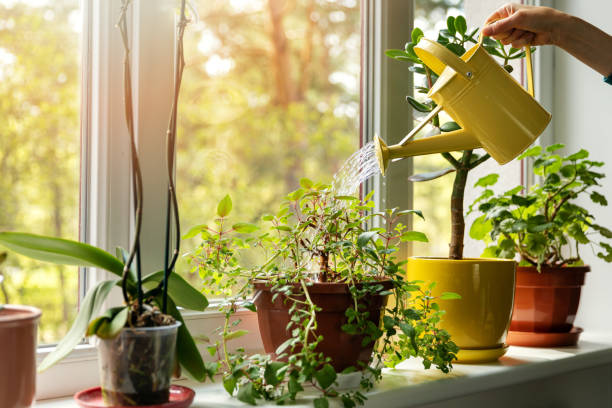Whimsical Window Gardens: Transforming Urban Views into Micro-Paradises
Imagine peering out your apartment window to find a cascading waterfall of vibrant flowers, a miniature herb garden bursting with fragrant basil and thyme, or a delicate fairy garden complete with tiny furniture and twinkling lights. Welcome to the enchanting world of window gardens, where even the smallest urban spaces can become lush, green havens that captivate the senses and nurture the soul.

The surge in popularity of window gardens can be attributed to several factors. Urbanization has led to smaller living spaces, prompting city dwellers to seek innovative ways to incorporate nature into their homes. Additionally, the growing awareness of the mental health benefits associated with greenery has inspired many to create their own pocket-sized sanctuaries.
Design Trends: Beyond the Basic Window Box
Modern window gardens are a far cry from the traditional geranium-filled boxes of yesteryear. Today’s designs incorporate a wide range of plants, materials, and technologies to create stunning visual displays that can change the entire atmosphere of a room.
One emerging trend is the use of vertical gardening techniques in window spaces. By utilizing hanging planters, tiered shelving, and even repurposed gutters, gardeners can create lush, multi-dimensional displays that maximize limited window real estate. These vertical gardens not only add visual interest but also allow for a greater variety of plants to be grown in a small area.
Another popular approach is the creation of themed window gardens. From zen-inspired rock gardens with miniature bonsai trees to tropical oases featuring exotic orchids and air plants, these themed displays transport viewers to far-off lands, all from the comfort of their own homes.
Innovative Materials and Technologies
The materials used in window gardening have also evolved. Self-watering planters with built-in reservoirs have made it easier for busy urbanites to maintain their gardens. Lightweight, weather-resistant synthetic materials mimic the look of stone or terracotta while being much easier to hang and maintain.
Technology has also found its way into window gardens. LED grow lights designed to fit discreetly into window frames allow for year-round growing, even in apartments with limited natural light. Smart sensors can monitor soil moisture, light levels, and temperature, sending alerts to your phone when your plants need attention.
Practical Benefits: More Than Just Pretty Flowers
While the aesthetic appeal of window gardens is undeniable, their practical benefits are equally impressive. For urban dwellers with limited outdoor space, window gardens provide an opportunity to grow fresh herbs, vegetables, and even small fruits. Imagine plucking fresh mint for your mojito or harvesting cherry tomatoes for your salad, all from your living room window.
Window gardens can also serve as natural air purifiers, improving indoor air quality by absorbing pollutants and releasing oxygen. In busy urban environments, this can make a significant difference in the overall health and well-being of residents.
Furthermore, strategically placed window gardens can provide natural insulation, helping to regulate indoor temperatures and potentially reduce energy costs. Dense foliage can act as a barrier against harsh sunlight in summer, while providing an extra layer of insulation in winter.
Creating Your Own Window Garden Oasis
Designing a window garden requires careful planning and consideration of several factors. First, assess the amount of natural light your window receives and choose plants accordingly. South-facing windows typically receive the most light, making them ideal for sun-loving plants, while north-facing windows are better suited for shade-tolerant species.
Next, consider the weight-bearing capacity of your window sill or frame. If you’re renting, check with your landlord before installing any permanent fixtures. For those with weight restrictions, consider using lightweight materials or hanging planters that distribute weight more evenly.
When selecting plants, think about the overall aesthetic you want to achieve. For a cohesive look, choose plants with similar care requirements that complement each other in terms of color, texture, and growth habit. Don’t be afraid to mix different types of plants – combining flowering plants with foliage plants can create a rich, layered look.
Maintenance and Care: Keeping Your Window Garden Thriving
Maintaining a window garden requires regular attention, but with the right approach, it can be a rewarding and relaxing hobby. Watering is crucial – most window gardens dry out faster than traditional gardens due to increased exposure to sun and wind. Consider installing a drip irrigation system or using self-watering planters to ensure consistent moisture levels.
Fertilization is also important, especially for flowering plants and vegetables. Use a balanced, water-soluble fertilizer and apply it according to the package instructions. Be cautious not to over-fertilize, as this can lead to salt build-up in the soil.
Regular pruning and deadheading will keep your plants looking their best and encourage continued growth and blooming. This is also an opportunity to shape your plants and maintain the overall design of your window garden.
The Future of Window Gardening
As urban populations continue to grow and green spaces become increasingly scarce, window gardening is poised to play an even more significant role in bringing nature into our homes. Innovations in hydroponic and aeroponic systems are making it possible to grow larger plants in smaller spaces, potentially allowing for small fruit trees or climbing vegetables to be grown in window gardens.
The integration of smart home technology with window gardening is another exciting frontier. Imagine a garden that automatically adjusts its own light levels, waters itself based on real-time weather data, and even rotates plants to ensure even growth – all controlled through your smartphone.
Window gardens represent more than just a trend in home decor or urban gardening. They are a testament to human creativity and our innate desire to connect with nature, even in the most unlikely of places. As we continue to push the boundaries of what’s possible in these small spaces, we’re not just transforming our windows – we’re changing our entire perspective on urban living, one tiny garden at a time.





